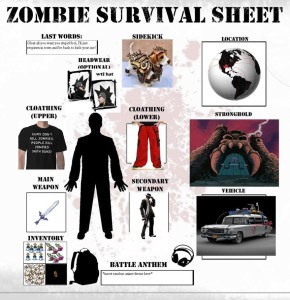Tag Archives: Megastore
ZOMBIE HISTORY – Zombie Scenes in the Bible
Zombies loom large in popular culture these days. Max Brooks’ “World War Z: An Oral  History of the Zombie War” (2006), the Jane Austen, Seth Grahame-Smith mashup “Pride and Prejudice and Zombies” (2009), and Melissa Marr’s “Graveminder” (2011), to name but a few recent novels, enjoy a wide readership. There are also graphic novels, the AMC television show “The Walking Dead,” video games, and of course movies. Some of my recent favorites in the latter category include the Norwegian Nazis-as-zombies film “Dead Snow” (2009) with its delightful tagline “Ein! Zwei! Die!” and Drew Goddard and Joss Whedon’s “The Cabin in the Woods” (2012). With all of this going on, there is little surprise to come across the open-source, collaborative Stinque Zombie Bible. It was just a matter of time, I suppose, and the King James Bible will never be quite the same.
History of the Zombie War” (2006), the Jane Austen, Seth Grahame-Smith mashup “Pride and Prejudice and Zombies” (2009), and Melissa Marr’s “Graveminder” (2011), to name but a few recent novels, enjoy a wide readership. There are also graphic novels, the AMC television show “The Walking Dead,” video games, and of course movies. Some of my recent favorites in the latter category include the Norwegian Nazis-as-zombies film “Dead Snow” (2009) with its delightful tagline “Ein! Zwei! Die!” and Drew Goddard and Joss Whedon’s “The Cabin in the Woods” (2012). With all of this going on, there is little surprise to come across the open-source, collaborative Stinque Zombie Bible. It was just a matter of time, I suppose, and the King James Bible will never be quite the same.
I am an unabashed zombie fan but also teach “classic” English literature and the New Testament so I can’t quite bring myself to desecrate the literary and religious masterpiece that is the Authorized (King James) Version by contributing to the Zombie Bible. Still, wanting to get into the spirit of things, I can’t resist noting a few biblical scenes and themes — a top 10 list — that come to mind each time I watch or read the latest version of the zombie apocalypse to come along. At least in some passages, a zombie-Bible mashup requires very little editorial interference.
1. The Gospel of Luke: “Why do you look for the living among the dead? He is not here, but has risen” (Luke 24:5). Such a suggestive phrase. Note also that the angels asking the question and those they address are standing inside a tomb at the time (Luke 24:2-4).
2. The Book of Revelation: “the sea gave up the dead that were in it” (Revelation 20:13). John the Seer’s creepy statement reminds me of a scene in George A. Romero’s “Land of the Dead” (2005) that features slow-moving corpses walking out of the surf, and Max Brooks’ “World War Z” with its account of the boy returning from a swim with a bite mark on his foot. He also describes the zombie hoards roaming the world’s oceans: “They say there are still somewhere between twenty and thirty million of them, still washing up on beaches, or getting snagged in fisherman’s nets.”
3. Deuteronomy: “Your corpses shall be food for every bird of the air and animal of the earth, and there shall be no one to frighten them away” (Deuteronomy 28:25-26; cf. 2 Samuel 21:10; Psalm 79:1-2; Isaiah 34:2-3; Jeremiah 7:33). The ancients worried about the exposure of their body after death. Improper care of one’s corpse was a terrifying prospect, so it is no wonder it features in prophetic warnings of divine wrath. Qoheleth insists that even though a man lives a long life and has many children, if he “has no burial … a stillborn child is better off than he” (Ecclesiastes 6:3). The indignity of non-burial presumably accounts for the honor bestowed on the poor man Lazarus in Jesus’ parable; the rich man receives proper burial but Lazarus “was carried away by the angels to be with Abraham” (Luke 16:22) because there was no one to care for his remains.
4. The Book of Job: “Why is light given to one in misery, and life to the bitter in soul, who long for death, but it does not come, and dig for it more than for hidden treasures…?” (Job 3:20-21). Job is angry he did not die at birth (3:11), adding that he loathes his life and does not want to live forever (7:16). Others prefer death to life out of principled anger against God, like the prophet Jonah (4:3; cf. 4:8). Physical death eludes a surprising number of people in the Christian Bible, and this is not always a welcome thing. The prophet John refers to some who “seek death but will not find it; they will long to die, but death will flee from them” (Revelation 9:6). The prospect of an elusive death, as every zombie fan knows, terrorizes the living. The “stricken” Charlotte Lucas in “Pride and Prejudice and Zombies” agrees to marry the tedious and obsequious minister Mr. Collins because she wants “a husband who will see to [her] proper Christian beheading and burial.” This is no small task for most survivors left with such a grim assignment, as Shaun well knows: “I don’t think I got it in me to shoot my flat mate, my mom, and my girlfriend all in the same evening” (“Shaun of the Dead,” 2004).
5. The Gospel of Matthew: “The tombs also were opened, and many bodies of the saints who had fallen asleep were raised. After [Jesus’] resurrection they came out of the tombs and entered the holy city and appeared to many” (Matthew 27:52-53). Unwanted persistent life is a recurring image in biblical literature and so too is language referring to the impermanence of bodily death. The dead do not stay dead. The psalmist is confident he will not “see decay” (Psalm 16:10 New International Version; cf. Acts 2:27; 13:35). We read of the physical resurrections of specific individuals (e.g., 1 Kings 17:17-24; Luke 8:49-56; maybe Acts 20:7-12) and expected mass revivals (e.g., 1 Thessalonians 4:16-17). Some of these accounts of un-dying involve reference to un-burying. Mary and Martha’s brother Lazarus walks out of his tomb when “they took away the stone” (John 11:41). On Easter morning, mourners find “the stone, which was very large, had already been rolled back” (Mark 16:4). A second century writer describes further the events preceding Jesus’ emergence from the tomb: “That stone which had been laid against the entrance to the sepulchre started of itself to roll and gave way to the side, and the sepulchre was opened” (Gospel of Peter9.35).
6. Ezekiel: Ezekiel receives a vision promising the restoration of Israel (37:11). Seeing a valley full of bones, the Lord instructs him to speak to them, saying, “O dry bones … I will cause breath to enter you, and you shall live. I will lay sinews on you, and will cause flesh to come upon you, and cover you with skin, and put breath in you, and you shall live” (37:4-6). When Ezekiel does so, “there was a noise, a rattling” as bones come together and sinew and skin appears and the breath of life returns. The dry bones “lived, and stood on their feet, a vast multitude” (37:7-10).
7. Zechariah: “their flesh shall rot while they are still on their feet; their eyes shall rot in their sockets, and their tongues shall rot in their mouths” (Zechariah 14:12). They seem to resemble extras in a George A. Romero film.
8. The Gospel of Mark: “hell, where their worm never dies” (Mark 9:48; alluding here to Isaiah 66:24). Gehenna (here symbolically representing “hell,” and usually translated so, as in Mark 9:44, 45, 47) refers to the Valley of Hinnom located to the south and southwest of Jerusalem. Following the reign of Israel’s righteous King Josiah (see 2 Kings 23:10-14), it became Jerusalem’s garbage heap, a place with maggots and rotting corpses. Jesus refers to this burning garbage in Mark 9:48, a place where residents of the city would leave the rotting corpses of humans and animals to the worms that do not die, to maggots. The image suggests the corpses of the damned rot ingehenna/hell — maggot ridden — in perpetuity.
9. 2 Maccabees: “[Antiochus IV Epiphanes] was seized with a pain in his bowels, for which there was no relief, and with sharp internal tortures — and that very justly, for he had tortured the bowels of others with many and strange inflictions … he fell out of his chariot as it was rushing along, and the fall was so hard as to torture every limb of his body. … the ungodly man’s body swarmed with worms, and while he was still living in anguish and pain, his flesh rotted away, and because of the stench the whole army felt revulsion at his decay. Because of his intolerable stench no one was able to carry the man who a little while before had thought that he could touch the stars of heaven” (2 Maccabees 9:5-6, 7, 9-10). The Syrian ruler’s physical body rots away zombie-like while he still lives. The cause is divine, as the God of Israel strikes this enemy of the Jews with “an incurable and invisible blow” (2 Maccabees 9:5).
10. Genesis with the Book of Revelation: “the earth was a formless void and darkness covered the face of the deep”; “the first heaven and the first earth has passed away, and the sea was no more” (Genesis 1:2; Revelation 21:1). With the disappearance of chaos, Eden returns: “On either side of the river is the tree of life with its twelve kinds of fruit” (Revelation 22:2; cf. Genesis 2:9). Horrors stories often wander back and forth between forms of paradise (ordered society) and chaos (some variant of an apocalyptic hellscape) thus recalling biblical stories with similar alternations. Zombie stories typically depict the disintegration of the modern world, and often hint at a return from the wilderness to the paradisiacal garden for survivors (cf. Genesis 3:23-24). Danny Boyle’s “28 Days Later” (2002), for one, ends with a developing romance between Jim and Salina, happy in the cultivated lands around a cottage that echoes Adam and Eve in the Garden of Eden. The sequel “28 Weeks Later” (2007), however, depicts a failed attempt to restore Eden. After the spread of the disastrous infection in the first film, the sequel documents efforts to repopulate the United Kingdom. Survivors return to their homeland, to what the director’s commentary refers to as “a new world” and a “Garden of Eden.” Naturally, mayhem ensues and the infection spreads as the movie unfolds. It wouldn’t be much of a horror movie otherwise.
‘God particle’ found – DOOMSDAY IS NEAR
GENEVA (AP) — Physicists say they have all but proven that the “God particle” exists. They have a footprint and a shadow, and the only thing left is to see for themselves the elusive subatomic particle believed to give all matter in the universe size and shape.
They have a footprint and a shadow, and the only thing left is to see for themselves the elusive subatomic particle believed to give all matter in the universe size and shape.
Scientists at the world’s biggest atom smasher plan to announce Wednesday that they have nearly confirmed the primary plank of a theory that could restructure the understanding of why matter has mass, which combines with gravity to give an object weight.
The idea is much like gravity and Isaac Newton’s discovery: It was there all the time before Newton explained it. But now scientists know what it is and can put that knowledge to further use.
The focus of the excitement is the Higgs boson, a subatomic particle long sought by physicists.
Researchers at the European Organization for Nuclear Research, or CERN, say that they have compiled vast amounts of data that show the footprint and shadow of the particle, even though it has never actually been glimpsed.
But two independent teams of physicists are cautious after decades of work and billions of dollars spent. They don’t plan to use the word “discovery.” They say they will come as close as possible to a “eureka” announcement without overstating their findings.
“I agree that any reasonable outside observer would say, ‘It looks like a discovery,'” said British theoretical physicist John Ellis, a professor at King’s College London who has worked at CERN since the 1970s. “We’ve discovered something which is consistent with being a Higgs.”
CERN’s atom smasher, the $10 billion Large Hadron Collider on the Swiss-French border, has been creating high-energy collisions of protons to investigate dark matter, antimatter and the creation of the universe, which many theorize occurred in a massive explosion known as the Big Bang.
The phrase “God particle,” coined by Nobel Prize-winning physicist Leon Lederman, is used by laymen, not physicists, more as an explanation for how the subatomic universe works than how it all started.
Rob Roser, who leads the search for the Higgs boson at the Fermilab in Chicago, said: “Particle physicists have a very high standard for what it takes to be a discovery,” and he thinks it is a hair’s breadth away. Roser compared the results that scientists will announce Wednesday to finding the fossilized imprint of a dinosaur: “You see the footprints and the shadow of the object, but you don’t actually see it.”
Fermilab, whose competing atom smasher reported its final results Monday after shutting down last year, said its data doesn’t settle the question of the Higgs boson, but it came tantalizingly close.
“It’s a real cliffhanger,” said Gregorio Bernardi, a physicist at the University of Paris who helped lead one of the main experiments at Fermilab. He cited “strong indications of the production and decay of Higgs bosons” in some of their observations.
Fermilab theorist Joseph Lykken said the Higgs boson “gets at the center, for some physicists, of why the universe is here in the first place.”
Though an impenetrable concept to many, the Higgs boson has until now been just that — a concept intended to explain a riddle: How were subatomic particles, such as electrons, protons and neutrons, themselves formed? What gives them their mass?
The answer came in a theory first proposed by Scottish physicist Peter Higgs and others in the 1960s. It envisioned an energy field where particles interact with a key particle, the Higgs boson.
The idea is that other particles attract Higgs bosons and the more they attract, the bigger their mass will be. Some liken the effect to a ubiquitous Higgs snowfield that affects other particles traveling through it depending on whether they are wearing, metaphorically speaking, skis, snowshoes or just shoes.
Officially, CERN is presenting its evidence this week at a physics conference in Australia but plans to accompany the announcement with meetings in Geneva. The two teams, known as ATLAS and CMS, then plan to publicly unveil more data on the Higgs boson at physics meetings in October and December. Each of the teams involves thousands of people working independently to ensure accuracy.
The scientific threshold for discovery is high. Scientists have to show with complex formulas that there’s a less than 1 in 1.7 million chance that the findings are a statistical fluke. With two independent experiments showing that there’s less than 1 in 16,000 chance of being wrong, it’s a matter of how their work is put together.
Scientists with access to the new CERN data say it shows with a high degree of certainty that the Higgs boson may already have been glimpsed, and that by unofficially combining the separate results from ATLAS and CMS it can be argued that a discovery is near. Ellis says at least one physicist-blogger has done just that in a credible way.
CERN spokesman James Gillies said Monday that he would be “very cautious” about unofficial combinations of ATLAS and CMS data.
“Combining the data from two experiments is a complex task, which is why it takes time, and why no combination will be presented on Wednesday.” he said.
But if the calculations are indeed correct, said John Guinon, a longtime physics professor at the University of California at Davis and author of the book “The Higgs Hunter’s Guide,” then it is fair to say that “in some sense we have reached the mountaintop.”
Sean M. Carroll, a California Institute of Technology physicist flying to Geneva for Wednesday’s announcement, said that if both ATLAS and CMS have independently reached these high thresholds on the Higgs boson, then “only the most curmudgeonly will not believe that they have found it.”
Man Eats Dog: High On Synthetic Cannabis, Waco Man Consumes Family Canine
A 22-year-old Texas man was arrested yesterday for allegedly attacking a neighbor  and eating his family’s dog alive.
and eating his family’s dog alive.
Michael Terron Daniel was allegedly high on a designer drug known as K2 at the time and was said to be “going crazy.”
Witnesses say Daniel informed residents at the Waco home where the incident took place that he was “on a bad trip from ingesting K-2″ — a type of synthetic cannabisknown to exacerbate existing psychoses — before getting down on his hands and knees and “chas[ing] a neighbor while barking and growling like a dog.”
He then proceeded to beat and strangle the family dog before biting into it, “ripping pieces of flesh away.” The dog was later pronounced dead at the scene.
According to Waco police Sgt. W. Patrick Swanton, officers arrived to find Daniel on the porch covered in blood. He asked the officers to fight him or use the stun gun “to help him get off his bad trip.”
Daniel was charged with felony cruelty to a non-livestock animal and booked into McLennan County Jail where he remains.
Doomsday Prep Survival Plans – Get A Ghillie Suit
San Fransisco, CA — (SBWIRE) — 06/25/2012 — Consumers interested in doomsday  preparation are seeking the tools, camouflage clothing and information necessary to arm themselves with an effective survival plan for a zombie apocalypse or end-of-days events. The right survival plan will include all of the items and details necessary to keep family and friend’s safe regardless of what may happen in the months and years to come.
preparation are seeking the tools, camouflage clothing and information necessary to arm themselves with an effective survival plan for a zombie apocalypse or end-of-days events. The right survival plan will include all of the items and details necessary to keep family and friend’s safe regardless of what may happen in the months and years to come.
GhillieSuitClothing.com is gaining attention as a source for extensive editorial content and a large collection of good quality ghillie suits, camouflage clothing enabling customers to go undercover, blending into nature, while maintaining the flexibility and comfort to move around.
Made from natural jute twine, burlap or synthetic thread, ghillie suits are designed to break up the human outline and resemble heavy foliage. GhillieSuitClothing.com features a wide-range of good quality ghillie suits, from the bushrag or warrior ghillie suit to the woodland jackal and zombie hunter ghillie suit.
The suits and camouflage clothing are organized into convenient categories on the left side-bar of each page on the site, so shoppers can find exactly what they need to meet their needs. Customers can go to the Popular Brands section on the side-bar to browse products from brand names, including GhillieSuits, Chameleon, CamoSystems and more. If they already know exactly what they need, shoppers can use the site’s search engine tool in the header.
Extensive editorial content throughout GhillieSuitClothing.com enables visitors to learn more about how to select the right ghillie suit and camouflage clothing items as well as how people are using these products for simulation sports, Halloween, undercover surveillance, hunting and in the military.
GhillieSuitClothing.com was designed to meet a previously unmet need for good quality ghillie suits, according to the site owner, “I was shocked to see the lack of information about commercial ghillie suits available so I started Ghillie Suit Clothing in 2007. Ghillie Suit Clothing was opened because I was frustrated when I was shopping for a ghillie suit. How was I supposed to make a decision based on one picture of a product or a vague description?”
“As the store owner, my goal was to create a store that presented its products with as much detailed and accurate information as possible. I am hoping that by doing so, consumers can make an informed purchase decision based on the correct information.”
Consumers can choose a product item to see high quality images as well detailed specifications and editorial content to provide customers with the knowledge they need to make an informed choice. The website’s blog is available in the header and provides additional high quality editorial content and customer photos.
Visitors to the site can sign-up for an account through the link in the header to create wish lists and proceed with making a purchase. GhillieSuitClothing.com provides exceptional customer service and will walk customers through the process to identify the right ghillie suits and camouflage clothing to meet their specific purposes.
About GhillieSuitClothing.com
GhillieSuitClothing.com has provided good quality ghillie suits and camouflage clothing since 2007. With a wide-range of product items, including the warrior ghillie suit, ghost ghillie suit, and ghillie suits for kids, the website assists customers through the process of finding all of the items they need for their doomsday survival plans. High quality images, in-depth editorial content, and user-friendly website navigation, make the site the preferred choice for consumers. For more information, visit http://www.ghilliesuitclothing.com
